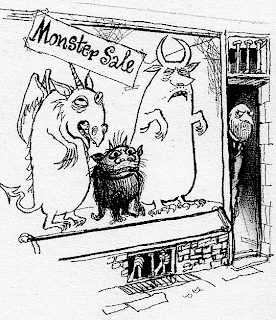I wanted to start this blog with a look at some of my favourite cartoonists over time. Being a brit, I want to focus on some of our home grown talent, in particular those comic illustrators prevalent in the middle years of the 20th century - from about 1945 to 1970. Why, you may ask, this period? Well in many respects this era is often overlooked in favour of the Golden age of cartoon and comic art, which in the UK is the period from 1900 to 1940, when many fine illustrators such as Bestall, Heath Robinson and Shepherd were at the peak of their powers. Yet interestingly, the generation of artists who would follow, in post war Britain, would perhaps best reflect the changing face of society, as it moved from a war damaged, austere nation to the booming society of the swinging sixties. Their work would provide a microcosm of the changes that the UK would undergo over this period. They would challenge many of the traditional conventions of cartoon art, often breaking with long held ideas and approaches. Increasingly they moved away from traditional or sentimental subjects , embracing instead the anarcharic, satricial and rude. These trailblazers would lay the foundations for the modern age of cartooning and their shadow over British and indeed world cartooning is significant.
Okay, so that introduction did have a lot of superlatives, but I do believe that this period was an important one. With that I want to focus on three cartoonists, who in my own opinion, perhaps contributed the most during this era: Ronald Searle, Carl Giles and Leo Baxendale. There are three reasons I wish to focus on these gentlemen. Firstly, they are all the highest rate cartoonists of any generation. Secondly, all were excellent gagsmiths, able to visualise a joke or a gag with perfection. But most of all, it was their ability to portray humanity at its most anarchic and wicked. All three would become famous for their unruly children (not literally of course). All three were able to show the worst of human nature, and yet, perhaps also the best.
Of these three, it is perhaps Ronald Searle who had the most success as a cartoonist. Searle, born in 1920 and who died only in December last year, was one of Britain's most celebrated cartoonists. Best known for his creation St Trinian's and his work on the Molesworth series, Searle has had a wide influence, not just on cartooning but beyond into animation (the look of Disney's 101 Dalmatians [1961], was based on Searle's style) and the wider visual arts. My own love for Searle comes from his ability to create so much from very simple line work. Take this St Trinian's illustation for example. Searle's line style is so simple yet conveys so much. I love his use of dip pen, which creates a line with so much raw energy. Look at the almost demonic expressions of the girls pulling the rack.
Searle was also a wonderful reportage illustrator. His drawings and observations of people in their surroundings are remarkable pieces of art in themselves.
The top image is of the characters observed around Spitalfields, London in 1953. The lower image of a public house in Germany in the 1960's. Searle enjoyed observing and drawing the people around him. Even his more nuanced observations though still have a sense of caricature about them. The people he illustrated seem larger than life. I love his confidence, being able to work directly in pen, yet still produce an accurate yet charismatic drawing, so full of life.
Finally I love his gag work. Often simple but always wonderfully put across.
Searle was truly a pioneer of modern cartoon art. He will be much missed.
Next time - another British genius - Carl Giles.
Thank you for reading and Good Night.





No comments:
Post a Comment